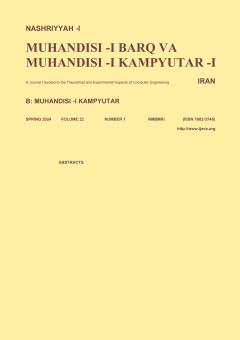Providing a Face Recognition System with an Optimal Selection of Features Based on the Cuckoo Optimization Algorithm
Subject Areas : مهندسی برق و کامپیوتر
Farnaz Hoseini
1
![]() ,
Hamed Sepehrzadeh
2
,
Hamed Sepehrzadeh
2
![]()
1 - Department of Computer Engineering, Technical and Vocational University (TVU), Tehran, Iran
2 - Department of Computer Engineering, Technical and Vocational University (TVU), Tehran, Iran
Keywords: Face recognition, feature optimization, cuckoo optimization algorithm, optimization algorithm,
Abstract :
Face recognition is a pattern recognition process that is specifically performed on faces. Face recognition has many applications in identifying credit cards, security systems, and other cases. Creating a face recognition system with high accuracy is a big challenge that has been the focus of various researchers in recent years. The feature extraction process and classification are two important issues in diagnosis systems that can play a significant role in increasing the accuracy of diagnosis. Considering this issue, in this study, taking into account the combined features and optimizing the cuckoo algorithm, a method to improve the accuracy of face recognition is proposed. In the presented method, seven features are extracted from the images in the database, and then by obtaining the feature vector, the steps related to feature selection are performed using the cuckoo algorithm. The proposed method has been implemented with MATLAB software and compared with other methods. The evaluation results show that the proposed method was able to perform the detection on the images of ORL and FDBB databases with 93.00% and 95.12% accuracy, respectively. The result obtained for this evaluation criterion has a higher value than other compared methods.
[1] A. Waqar, W. Tian, S. Ud Din, D. Iradukunda, and A. Aman Khan, "Classical and modern face recognition approaches: a complete review," J. of Multimedia Tools and Applications, vol. 80, no. 3, pp. 4825-4880, Jan. 2021.
[2] S. Koosha and M. Amini, "Machine learning and deep learning: a review of methods and applications," J. of World Information Technology and Engineering, vol. 10, no. 7, pp. 3897-3904, May 2023.
[3] ف. حسینی، ا. طبیب¬زاده لمر و سید مهدی میرکاظمی نیارق، "تشخیص چهره با داده¬های ناقص توسط شبکه عصبی کانولوشنی عمیق "(DCNN)، پذیرفته برای انتشار در مجله علمی محاسبات نرم، مرداد 1403.
[4] R. Mayank Kumar and D. Kumar Singh, "A comprehensive survey on techniques to handle face identity threats: challenges and opportunities," J. of Multimedia Tools and Applications, vol. 82, no. 2, pp. 1669-1748, Jan. 2023.
[5] G. Soumia, D. Benboudjema, and W. Pieczynski, "A new hybrid model of convolutional neural networks and hidden Markov chains for image classification," J. of Neural Computing and Applications, vol. 35, no. 24, pp. 17987-18002, Aug. 2023.
[6] N. Yifan and W. Deng, "Federated learning for face recognition with gradient correction," J. of Proc. of the AAAI Conf. on Artificial Intelligence, vol. 36, no. 2, pp. 1999-2007, Jun. 2023.
[7] R. Ramin, "Cuckoo optimization algorithm," J. of Applied Soft Computing, vol. 11, no. 8, pp. 5508-5518, Dec. 2023.
[8] A. Manar Abdulkareem, "Cuckoo search algorithm: review and its application," Tikrit J. of Pure Science, vol. 26, no. 2, pp. 137-144, Apr. 2021.
[9] D. Garg, P. Jain, K. Kotecha, P. Goel, and V. Varadarajan, "An efficient multi-scale anchor box approach to detect partial faces from a video sequence," J. of Big Data and Cognitive Computing, vol. 6, no. 1, pp. 1-9, Jan. 2022.
[10] H. Yan, X. Wang, Y. Liu, Y. Zhang, and H. Li, "A new face detection method based on Faster RCNN," J. of Physics: Conf. Series, vol. 1754, no. 1, Article ID: 012209, 5 pp., 2021.
[11] H. S. Avani, A. Turkar, and C. D. Divya, "Face detection and natural language processing system using artificial intelligence," In: G., Ranganathan, J., Chen, and A. Rocha, (eds) Inventive Communication and Computational Technologies, LNNS, vol. 89, pp. 773-780, 2020.
[12] S. Tangina, M. Delowar Hossain, N. Hasan Zead, N. Alam Sarker, and J. Fardoush, "A new approach for efficient face detection using bpv algorithm based on mathematical modeling," in Proc. of Int. Joint Conf. on Computational Intelligence, pp. 345-358, Dhaka, Bangladesh, 20-21 Nov. 2020.
[13] A. Seema and J. A. Kendule, "Face detection and recognition using combined DRLBP and sift features with fuzzy classifier," in Proc. of International Joint Conference on Advances in Computational Intelligence, pp. 133-143, 20-21 Nov. 2020.
[14] A. Elmahmudi and H. Ugail, "Deep face recognition using imperfect facial data," J. of Future Generation Computer Systems, vol. 99, no. 1, pp. 213-225, Oct. 2019.
[15] R. Vinothkanna and T. Vijayakumar, "Using contourlet transform based RBFN classifier for face detection and recognition," in Proc. Int. Conf. on ISMAC in Computational Vision and Bio-Engineering pp. 1911-1920, Palladam, India, May 2020.
[16] Z. Huiling and K. Lam, "Age-invariant face recognition based on identity inference from appearance age," J. of Pattern Recognition, vol. 76, no. 1, pp. 191-202, Apr. 2018.
[17] H. Sungeun, W. Im, J. Ryu, and H. S. Yang, "SSPP-DAN: deep domain adaptation network for face recognition with single sample per person," in Proc. IEEE Int. Conf. on Image Processing, pp. 825-829, Beijing, China, 17-20 Sept. 2017.
[18] A. Vinay, G. Kathiresan, D. Akhil Mundroy, H. Nihar Nandan, C. Sureka, K. Balasubramanya Murthy, and S. Natarajan, "Face recognition using filtered eoh-sift," J. of Procedia Computer Science, vol. 79, no. 1, pp. 543-552, Jan. 2016.
[19] S. Syed Afaq Ali, M. Bennamoun, and F. Boussaid, "Iterative deep learning for image set based face and object recognition," J. of Neurocomputing, vol. 174, no. 1, pp. 866-874, Jan. 2016.
[20] A. Wadhah, W. Elhamzi, I. Charfi, and M. Atri, "A hybrid feature extraction approach for brain MRI classification based on bag-of-words," J. of Biomedical Signal Processing and Control, vol. 48, no. 1, pp. 144-152, Feb. 2019.
[21] J. Brendan and H. S. Le, "Precision-recall versus accuracy and the role of large data sets," J. of Proc. of the AAAI Conf. on Artificial Intelligence, vol. 33, no. 1, pp. 4039-4048, Jul. 2019.


